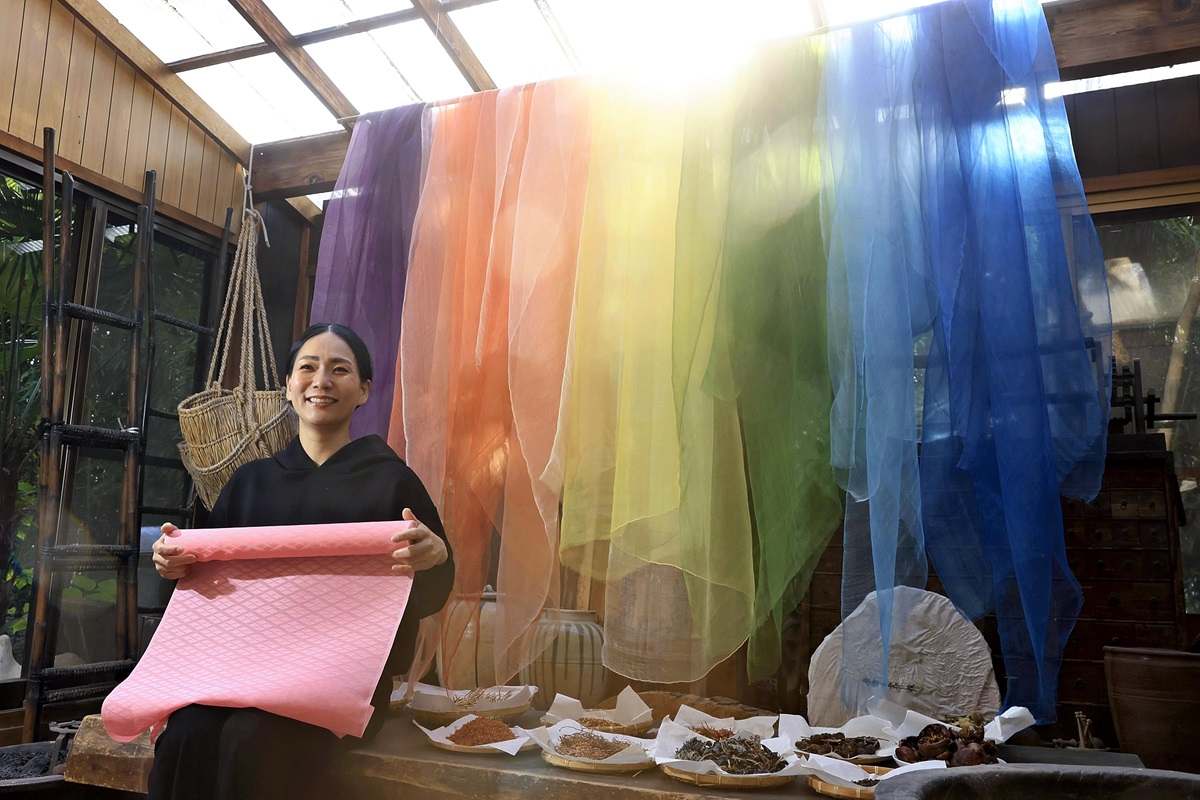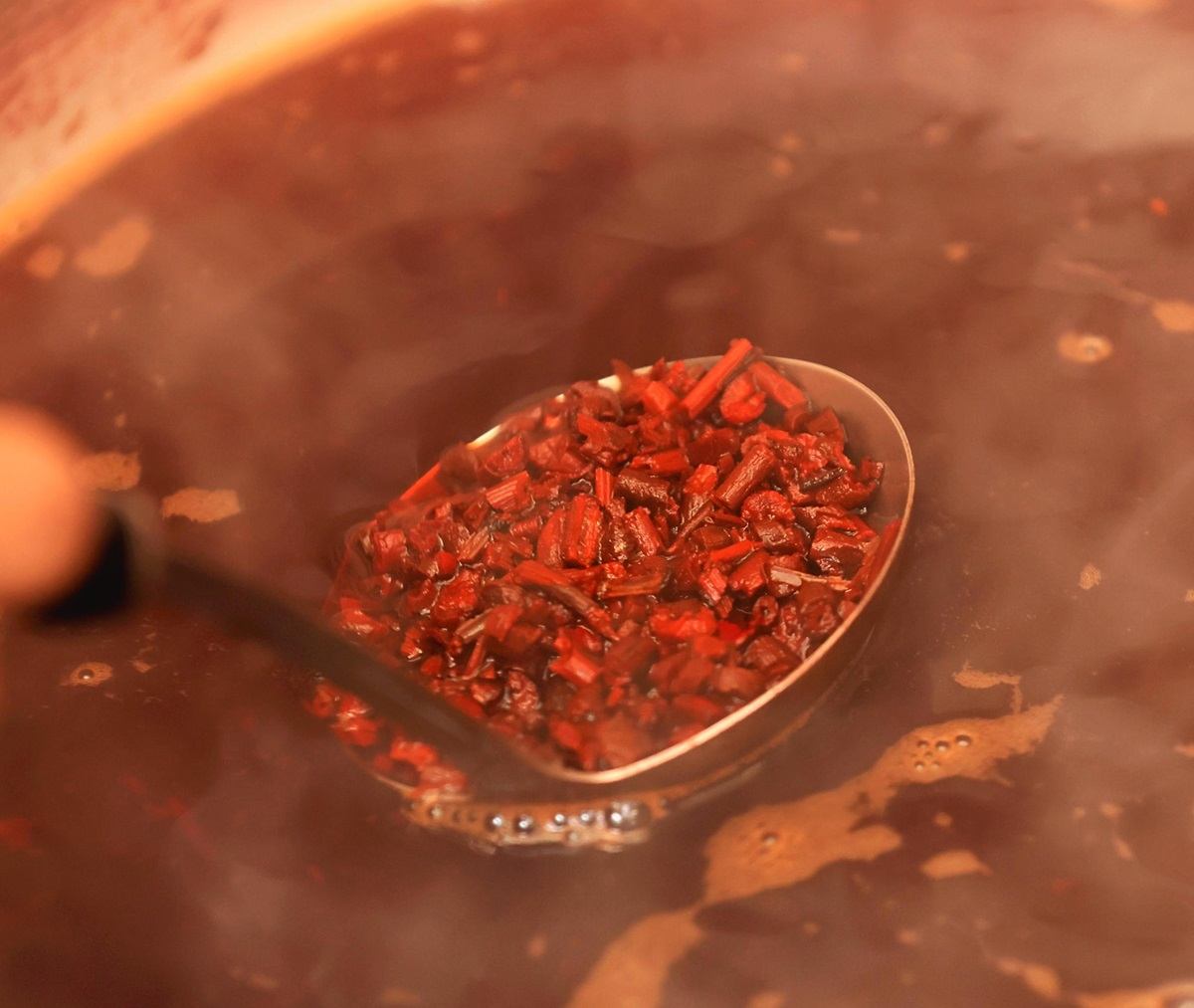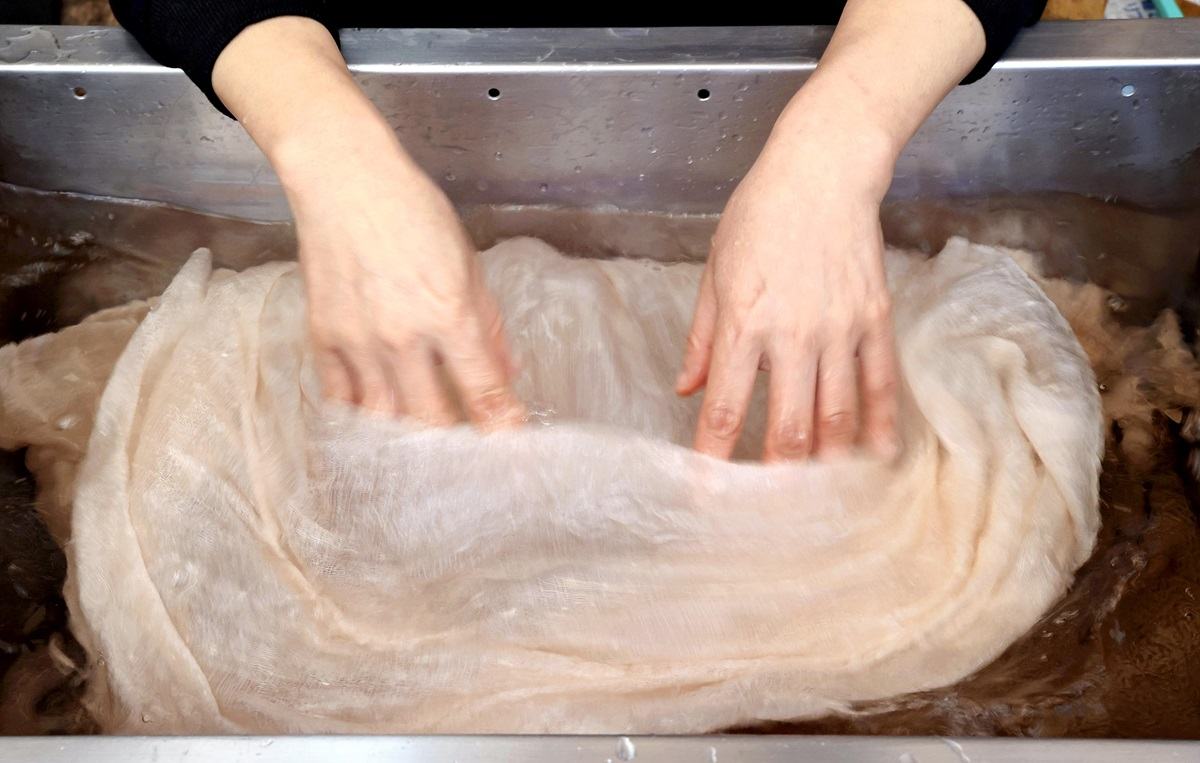Heirs to Kyoto Talent / Dyer Adds Life to Cloth with Color from Plants Applying Sharp Eye to Centuries-old Techniques

Sarasa Yoshioka sits beside dried plants used for dyeing in Fushimi Ward, Kyoto.

11:24 JST, February 10, 2024
KYOTO — Sarasa Yoshioka seems to be able to imagine colors that can be harvested from plants — such as gromwell roots, safflower petals, madder roots and acorns.
She dissolves the pigments extracted from plants in water that was pumped up from 100 meters underground, and soaks a plain cloth of silk, linen or cotton in it.
Initially, she has no guarantee of what the color will be. Scrutinizing with a sharp eye, she makes fine adjustment, gradually getting closer and closer to the color she envisions.
Dyeing and weaving artist Yoshioka is the sixth-generation master dyer of Textile Dyer Yoshioka, or Some no Tsukasa Yoshioka in Japanese, a business that dates back to the 1800s.
“We have an expression, ‘wet color of a dyehouse,’” she said.
The most beautiful colors are those of freshly dyed cloth that is still wet when it is hung up to dry, she explained. “This is a privilege that only the dyer can see.”

Yoshioka puts the plants in hot water to release the color.

Cloth is dyed to an ideal color over time.
No synthetic dyes
In the past, there were many dyehouses in Kyoto bearing the name “Yoshioka.”
The first generation of Textile Dyer Yoshioka, who was granted the right to use the name, founded the business in the Tanoji area in the center of the city.
When modernization during the Meiji era (1868-1912) led to the spread of chemical dyes, Yoshioka’s grandfather and the fourth-generation head of the shop, Tsuneo, was inspired by the beauty of the Shoso-in treasures and began researching natural dyes harvested from plants. Tsuneo moved his workshop to the current location near the Uji River in Fushimi Ward, Kyoto.
The shop’s fifth-generation head was Yoshioka’s father, Sachio, who made a decision not to use any synthetic dyes. He pursued the beauty of natural colors using ancient techniques that employed dyes harvested from plants. He became a leading color historian.
Yoshioka was his third daughter. Her earliest childhood memory is of a workshop with the smell of dyes and steam rising from the air.
After graduating from university, Yoshioka’s interest in the family business grew as she learned about clothing as a sales representative for a fashion brand.
Her father recommended that she work at the Nomura Silk Museum in Seiyo, Ehime Prefecture. For two years in the town where sericulture flourished, she acquired practical knowledge ranging from yarn-making to dyeing and weaving.
She began her training at a local workshop in 2008, when she was over 30 years old. It took about five years before she was able to produce the colors she intended.
She has been entrusted with the task of dyeing artificial camellia flowers for the annual Shunie ceremony, also known as Omizutori, at Todaiji temple in Nara.
In 2019, her father passed away from a heart attack while on a trip. Unprepared, she assumed the position of the sixth-generation head of the dyehouse.
Bringing nature closer
She remembers that when she asked her father why people dye cloth and clothes, he told her about his experience of being moved by the beauty of nature such as the sun, the moon, the sky, the ocean, mountains, rivers, trees, flowers and grass.
He thought that dyeing cloth began when people started to think about how to bring this beauty closer to themselves, she said.
The workshop’s technique of using natural dyes harvested from plants is not different from ancient techniques used in the eighth and ninth centuries.
Guided by her predecessors, Yoshioka came into contact with classical literature. In “The Tale of Genji,” for example, author Murasaki Shikibu describes the characters’ costumes in great detail.
“I don’t know exactly what kind of colors they are, but when I let my imagination run wild, I can link them to what I’m dyeing,” she said.
All colors may theoretically be considered as combinations of cyan, magenta and yellow. Nowadays, we can represent colors in any number of ways with computers. Even so, she believes that colors extracted from natural plants have a depth that evokes “warmth” and “the source of life,” as her father used to say.
She is sometimes overwhelmed by the history of her predecessors. But now, she shares her thoughts with them. She has come to love the colors harvested from plants: “They allow me to feel the four seasons of Kyoto and the workings of nature,” she said.
***
If you are interested in the original Japanese version of this story, click here.
"Features" POPULAR ARTICLE
-

Sanrio to Open Museum in Yamanashi Pref. Dedicated to Founder, Exhibits Include Hello Kitty, Other Characters
-

Autumn Foliage Surrounds Visitors to Tokyo’s Showa Kinen Park
-

My Daughter No Longer Speaks to Me, But I Want to See Her and My Grandchild
-

Kumamoto: Public Bath Refurbished as Library Where You Can Chat, Take Photos
-

Frozen Vegetables: Demand Rises for Convenient, Tasty Domestic Produce
JN ACCESS RANKING
-

Keidanren Chairman Yoshinobu Tsutsui Visits Kashiwazaki-Kariwa Nuclear Power Plant; Inspects New Emergency Safety System
-

Imports of Rare Earths from China Facing Delays, May Be Caused by Deterioration of Japan-China Relations
-

Tokyo Economic Security Forum to Hold Inaugural Meeting Amid Tense Global Environment
-

University of Tokyo Professor Discusses Japanese Economic Security in Interview Ahead of Forum
-

Japan Pulls out of Vietnam Nuclear Project, Complicating Hanoi’s Power Plans



























